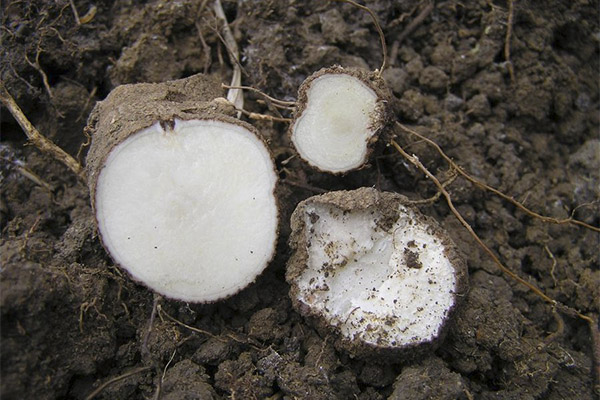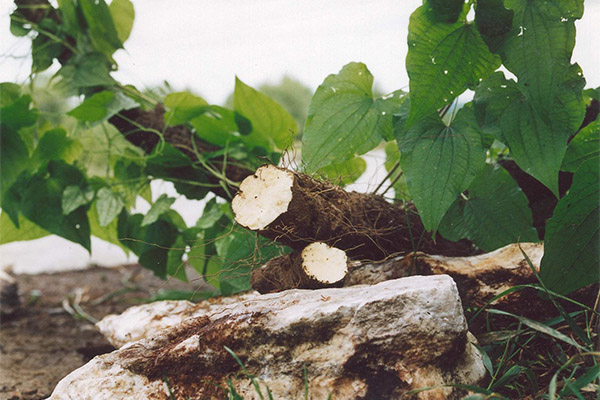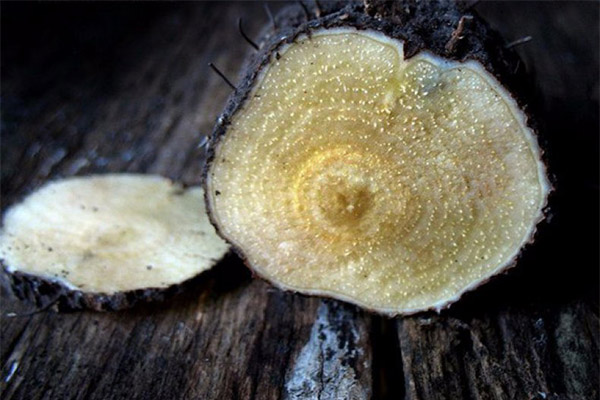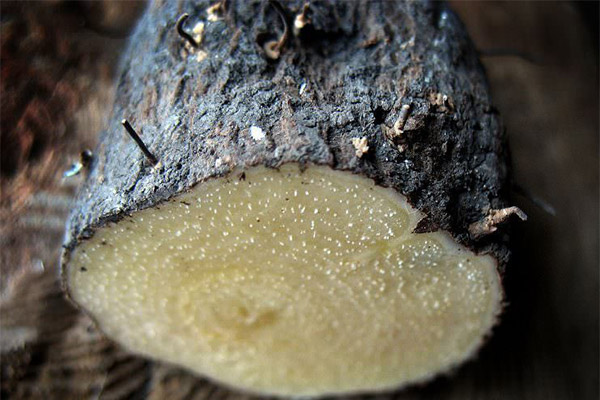Adam's root: medicinal properties and uses
Where did the name of the plant Adam's root come from - tells an entertaining legend. Allegedly, Adam, walking in the Garden of Eden, did not notice the sticking out old roots and stumbled. The result of this awkwardness was an injured leg. His faithful wife and friend Eve, in search of a natural remedy, happened to find a previously unknown liana. The girl decided to try to help her beloved, using this plant. It turned out that her intuition did not fail her, and Eva found the right way to use it: she cut the root and put it on the wound, and then secured it with a bandage. Thanks to the unique properties of the liana, Adam's sore leg healed quite soon. And since then, Adam's root has been widely used by folk healers in the Caucasus.
- Chemical composition
- How it looks and where it grows
- Gathering and storage
- Therapeutic properties of adam's root
- Adam's root medicinal uses
- Massage Oil
- Remedy for injuries
- Massage for rheumatism
- Tincture for sciatica
- For joint treatment
- For warts
- Infusion for hemorrhoids
- From stomatitis
- Tincture for Vessels
- From varicose veins
- From stomach ulcers
- From cystitis
- From infertility
- From inflammations of the appendages
- For a stronger body
- Kinds of medicinal compositions
- Infusion
- Tincture
- Ointment
- Poultices
- Contraindications to use
Chemical Composition
The scientific name of Adam's root - tamus ordinary (or Dioscorea ordinary). Biologists have discovered that all parts of the plant, both underground and above-ground, are rich in biologically active substances and compounds.

- For example, tamus contains saponins and tannins, which give the plant an anti-inflammatory effect. The presence of pectins gives the plant the ability to activate blood circulation, and purify the blood and help strengthen blood vessels steroid substances contained in adam's root.
- The natural pigment lycopene gives tamus its antioxidant properties, while triterpene compounds and mucilage accelerate the regeneration of mucous membranes, relieve inflammation and irritation.
- The roots of the plant are rich in natural acids, including formic acid, which is a good stimulator of cellular metabolism, oxalic acid, which supplies the human body with iron and magnesium, and brinolic acid, which is involved in the regulation of lipid metabolism.
- Adam's root contains fatty oils that help relieve pain due to their ability to affect nerve endings.
- Essential oils and resins are also components of adam's root. In addition, the plant's list of useful substances includes trace elements and carbohydrates that have a histamine effect.
- Thamus contains a group of substances that make this plant poisonous: alkaloids, coumarins and glycosides. When used correctly and in the proper dosage, they have a therapeutic effect, but uncontrolled use can cause hallucinations, heart disruption - up to and including death.
What it looks like and where it grows
Adam's root is a perennial plant, which belongs to the herbaceous, but does not look like a herb at all, as it grows up to 4 m. Since it is essentially a liana, it has short spines and whiskers on its stems, with the help of which it clings to a support and crawls upwards, towards the sun.
The leaves of the plant are strongly egg-shaped, medium-sized, about 10 cm long, attached to long petioles, and alternately arranged on the stem. The leaves are serrated or carved along the edge and slightly rough to the touch.
Tamus is a dioecious plant, meaning that its male and female flowers are formed on different individuals and cross-pollinated. The unisexual flowers are small, with a simple perianth of a yellow-greenish tint. The flowers are arranged in inflorescences that form brushes: the male ones are quite long, while the female ones are shorter and more unsightly. Flowering begins depending on the area where the liana grows - from April to June.
Fruits are round red berries about 1 cm in diameter, which can be seen starting in July. Inside each berry there are 3 to 6 round red-brown seeds, about 3 mm in size. The fruits are highly poisonous. That is why they should never be consumed internally.
Tamus is characterized by a very thick, juicy and fleshy tuberous root. It is rod-shaped and may divide into 2 or even 3 separate rods deep in the soil. Inside it is snow-white, clean, juicy and as if even oily, greasy to the touch. On the outside it is brown or brown and covered with numerous adventitious roots. The root can grow to a length of up to 1 m and in old plants can weigh up to 15 kg.
In nature, adam's root prefers forested mountainous terrain. Most of the 600 species settle in the tropics, but there are varieties that take root in mountainous and forested areas with temperate climates. It occurs in the Mediterranean and Asian countries, in northern Africa, in Eastern Europe, including - and occasionally - and in Ukraine, Moldova and Belarus. In Russia it grows in the Crimea and the Caucasus.
It is also possible to grow tamus in the middle belt under certain conditions. Although the plant is quite frost-resistant, it is better to cover it in case of a frosty winter with little snow - similarly to the way roses are covered.
Note that adam's root does not tolerate excessive frosting of the soil, although it likes wet soil. Drainage when planting is mandatory, it is necessary to additionally sprinkle lime under the plant. To prevent the soil from drying out too quickly, it is better to plant it in the penumbra, water regularly and be sure to mulch the soil. In autumn, when the shoots die off, the plant should be cut short, and the following year, shoots will reappear from the root.
If you follow these simple rules, you can grow a liana, which will become a real decoration of the garden plot.
Collection and storage
For medicinal purposes, the root of tamus is usually used. Prepare the raw material when there are no green shoots. Theoretically it can be both spring and autumn. But in the spring it is difficult to find the root in the ground, so it is better to do it immediately after the shoots are cut, starting in September and continuing until the frost.
Since the sap of Adam's root usually causes irritation on the skin, you need to prepare for digging it: wear long-sleeved clothes and thick rubber gloves. Digging will take a long time, because the root is long and goes deep into the soil. In addition, it clings firmly to the stony ground and intertwines with the rhizomes of other plants. This is probably why people have given the adam's root another name - kink.
Once the root is dug up, you need to shake it out of the ground and rinse it thoroughly. After that, cut it into thin slices not more than 8 cm long and dry it. You can, of course, spread in a well ventilated place. But as practice shows, in the fall or early spring, when there is a collection of medicinal raw materials, the weather is usually bad: it rains often, cold mornings with dew are possible. Therefore, the raw material can begin to spoil - moldy or rotten. It makes sense to dry the root in an electric dryer at minimum temperature. Ready raw material is a bitter, dark colored hard pieces.
For long-term storage, the raw material should be placed in a warm, dry room, where in a cloth bag or glass container it will not lose its useful properties for 2 years. If you want to keep the root fresh, it is stored in the refrigerator. But such raw material is stored no longer than a month.
Medicinal properties of Adam's root
Of course, the story about the biblical Adam and Eve and the name Adam's root is just a beautiful fairy tale. But the fact that the plant has been used by folk healers in the Caucasus since ancient times is a historical fact. The rest of the world learned about its healing properties much later - already in the XVII century. And documentary evidence of the use of Adam's Root for medicinal purposes appeared another century later, when Christopher Hufeland, the King of Prussia's lieutenant physician, described its properties in scientific articles, emphasizing that the plant was effective for lung diseases and other ailments.
To this day, not only folk medicine, but also official medicine recognizes adam's root as a medicinal plant. Its use is based on the ability of the tamus to stimulate local blood circulation and intestinal peristalsis, thus improving the function of the digestive system. Medicine also uses the ability of the plant to accelerate tissue regeneration, stop the blood, have a restorative, antioxidant, anti-cough and diuretic effects, as well as reduce edema.
On the basis of these medicinal properties, adam's root can be used to treat bronchitis and various inflammations: middle ear, bladder and kidney, uterine appendages, pneumonia. The plant is recognized for its effectiveness in alleviating hemorrhoids and varicose veins, and for treating stomach ulcers as a complementary remedy. Adam's root is used to get rid of warts and eczema.
Adam's root is especially noteworthy for its possible use in various diseases of the bone tissues, ligaments, muscles and joints, as well as in acute inflammatory processes in the nerve endings. Healing compositions prepared with the use of tamus, have a pain-relieving effect in rheumatism, sciatica, osteochondrosis, heel spurs, sprains and strains, gout, arthritis, arthrosis and sciatica. And the high content of minerals provides faster recovery from bruises and bone fractures. The ability to stimulate tissue regeneration is in demand when you need to get rid of bruises, bruises, heal wounds faster.
Adam's root medicinal uses
Of medicinal plants, physicians recommend adam's root in the first place when it comes to diseases of the joints or disorders in the circulatory system. Its ability to relieve pain is more powerful than other natural remedies, so it is especially recommended for patients who, for whatever reason, have a strong contraindication to pharmaceuticals.

In medical practice, the most commonly used remedies from the dried or fresh root of the plant, much less often - from the leaves. The root is usually used crushed to a powdered state. Usually from the medicinal raw materials do infusion and tincture, balsam and decoction or ointment. These compositions are used externally, rubbing the sore spot or making compresses, poultices and poultices. Sometimes, remedies with adam's root are used in massages.
Inside the healing compositions are also used, but with special caution, because the plant is poisonous. The main thing is not to exceed the prescribed dosage and frequency of ingestion.
In the pharmacy adam's root is sold in dry form, ground to powder form, as well as a tincture in alcohol.
Massage oil
To prepare the massage oil 50 grams of dry powder from Adam's root pour half a liter of sunflower oil (flavored, unrefined). Insist the remedy for two weeks in the refrigerator. Do not strain! Use this oil to rub and massage the sore spots with varicose veins, bruises. Effective means is also for the gentle elimination of pain in joint disease.
Remedy for bruises
About this recipe was used by the biblical Eve to cure Adam's leg. For this, you need a fresh root of the plant, which should be grated or just finely chopped with a knife. The resulting mass should be scalded with boiling water, immediately wrapped in gauze and put on the sore spot - a bruise or abrasion. If there is no time or opportunity to deal with boiling water, you can simply sprinkle the wound with dried powder of adam's root. The effect will also be quite good.
Rheumatism compress
To eliminate joint pain in rheumatism or pain in the lower back in sciatica, you can make a compress. To make it, pour a glass of boiling water 2 tablespoons of crushed dried adam's root. Cover the container with a saucer or lid and allow to stand for 10 minutes so that the remedy slightly steamed. Then drain the water and wrap the roots in gauze or cotton cloth. Put a compress on the sore spot and keep it for about an hour. Repeat this procedure 2 or 3 times a day, the raw material should be warm, just steamed. This remedy is not forbidden to use at least every day for a long time.
Tincture for sciatica
In addition to sciatica, this remedy can be used for rheumatism, diseases of the joints and ligaments.
You need to take 200 grams of dry crushed Adam's root. Pour the herb in a dark glass container half a liter of good vodka. Insist 12-15 days at room temperature, preferably placed in a closet to avoid sunlight. During this time, the contents of the container should be stirred or shaken.
Apply the resulting tincture is best before bedtime: rub the sore spot and wrap with a warm scarf or scarf. It is allowed to repeat this procedure every day.
For the treatment of joints
For the preparation of healing compositions of Adam's root, you can use other components that will enhance the effect of the useful substances of the plant. So, you can supplement the root with honey. To do this, take 300 grams of honey for 50 grams of dry crushed medicinal raw materials, mix the ingredients well.
Rub the painful joint with alcohol or vodka and smear the resulting mixture. Then cover the joint area with plastic wrap and wrap with a warm scarf or scarf. Keep this compress for 3 hours.
For warts
Grind adam's root to a powdered state, you can take ready-made pharmacy powder. Thoroughly mix it with boric ointment and apply it to the wart. Bandage on top. After a day, replace the bandage with a fresh one. Repeat until the wart turns black.
The same recipe is suitable for dermatitis and eczema.
Infusion for hemorrhoids
0.5 teaspoon of adam's root powder pour a glass of boiling water. The infusion is ready in 3 hours. Drink it orally 3 times a day - 1 tablespoon. In severe cases, it is allowed to increase the frequency of intake up to 5 times, but no more - and that after consulting with the doctor. The treatment period of 3 weeks, at the end of which a break should be made for a week, then repeat the course.
Folk healers assure that the same remedy has a positive effect in the treatment of rheumatism and impotence.
From stomatitis
To rinse the throat with sore throat or mouth cavity with stomatitis, gingivitis, an infusion of the medicinal plant is shown. Its concentration should be higher than for ingestion. That is, for a glass of boiling water, take a full, with a slide, a teaspoon of dried adam's root powder. Brew it, infuse it for 3 hours - and you can start gargling.
Tincture for blood vessels
The tincture will help strengthen the blood vessels of those who suffer from varicose veins, as well as patients who have had a stroke.
Pour 300 ml of quality vodka 1 tablespoon of ground to powdered Adam's root. Insist in a dark place, shaking every day. After 10 days, you can take, diluting 10 drops in half a glass of water. Drink in the morning and evening, 10 minutes before a meal. Treatment can be taken for a month, then a break for 2 weeks and repeat the treatment. The number of courses is unlimited.
From varicose veins.
Good helps to normalize blood vessels, which, in addition to Adam's root, include horse chestnut and Japanese Sophora. You need to take 1 teaspoon of powder from the root and 1 tablespoon of Sophora fruits and crushed chestnut bark. Pour a mixture of medicinal plants with a glass of boiling water. Insist for 3 hours, covered with a warm blanket. Take 1 tablespoon before each meal, that is 3-4 times a day.
For a stomach ulcer.
Grind dried adam's root to a powdered state and mix with butter and honey. Take all components in equal parts - 1 tablespoon each. The resulting mixture to eat 1 teaspoon before each full meal - breakfast, lunch and dinner.
From cystitis
Cystitis is more pleasant to treat with a tincture of Adam's root in wine. To do this, pour 100 grams of raw materials into a bottle of red dry wine. You can use both dried root and fresh. You don't need to make it into a powder, it's enough to chop it in small pieces. Insist at least 3 days, strain and store in the refrigerator. It would be good to always have this remedy in the home arsenal, if there is a tendency to cystitis. With attacks of the disease, drink the wine tincture by 1 tablespoon after each meal.
For infertility
This recipe is suitable for both women and men, and they use not the roots but the green part of the plant - the stems and leaves - for the preparation of the healing remedy.
You should chop the herbs, take 1 tablespoon and pour a glass of boiling water, then leave them under a lid for 3-4 hours. When the composition is infused, strain it and drink it 4 times a day.
From inflammation of the appendages.
In the treatment of inflammations of the female genital sphere, a tincture is recommended, which is made from 1 tablespoon of fresh, finely chopped root and 0.5 liters of alcohol. Insist the remedy for 10 days. Then be sure to strain, can be stored at room temperature, but in a dark cupboard. Drink after 30 minutes after a meal. For a single reception, 1 tablespoon of tincture should be diluted in half a glass of boiled water.
To strengthen the body
For general strengthening of the body, to raise the tone prepare a tincture on white wine. Pour 100 grams of dry raw materials into a bottle with wine and insist for 3 weeks. The main thing is not to forget that it is a medicine, so you can not overdo it. Drink after straining in therapeutic doses - 30 grams no more than 3 times a day.
Types of medicinal compositions
In pharmacies, adam's root is sold in the form of ready-made dry powder and balm for the treatment of joints. But you can also prepare medicines at home, on your own.

Infusion
The least amount of side effects, including allergic reactions, gives such a composition as an infusion. It can be used internally, and make with it compresses and lotions to treat many diseases. In infusion, it is easier to adjust the concentration of other dosage forms.
To prepare a classic infusion of 0.5 teaspoons of dried ground adam's root pour a glass of boiling water and insist under a closed lid for 2 hours. Strain and can be used. The recommended dosage for oral administration - 1 tablespoon 3 times a day, preferably after a meal.
Tincture
Tinctures of Adam's root can be made in alcohol, vodka or oil. To alleviate joint pathologies, relieve pain, the most suitable are tinctures made on vodka. Remember the general rule: alcoholic tinctures should be infused in a dark glass bowl in a place where direct sunlight does not reach. Under the influence of light, the root loses its useful properties.
- Pour a bottle of vodka (500 ml) 200 grams of dried raw materials. Insist for a week, then you can use for rubbing. If you intend to take a tincture inside, for the same amount of vodka take 100 grams of the root.
- Pour 400 grams of dried shredded Adam's root 1 liter of alcohol. Insist 2 weeks in a cool place. From time to time shake the container. It is better to use the prepared remedy, applying it not on the skin, but on gauze or cotton cloth, which is then put on the sore spot.
- Oil tincture is prepared from 50 grams of crushed dry adam's root and 1 liter of vegetable oil. Insist 10 days in a cool place. Use externally to relieve pain when sprained ligaments, bruises or sciatica.
- As an alternative to vodka or alcohol can be used dry wine as the basis of tincture. The proportion is as follows: 100 grams of dried root - 500 ml of wine. You can add a drop of honey. Such a tincture is good for treating ailments of the kidneys and the excretory system.
Ointment
Ointment with Adam's root is suitable for warming, it is also effective in relieving pain in the joints, muscles and ligaments. To prepare the ointment, you need a fresh root of the plant. It must be grated and mixed with petroleum jelly or massage gel. For 100 grams of gel or vaseline take 10 grams of grated root. Store the ointment in the refrigerator.
The area of the joint should be rubbed with the homemade ointment and insulated with a woolen scarf or kerchief.
Poultices
According to patient reviews, poultices from Adam's root help relieve muscle or rheumatic pain, relieve nagging heel spurs, relieve bruises or sprains, inflammation of the sciatic nerve.
To prepare a poultice, you need to pour boiling water 2 tablespoons of crushed root and wait 10 minutes until steaming. Then drain the water, and the hot raw material to wrap in gauze or cotton cloth and a couple of hours to put on the painful joint or muscle.
Contraindications to use
Patients who have used adam's root, usually speak of the medicinal plant in a positive way. But still, every therapeutic agent has contraindications. First of all, you should not take the compositions prepared from adam's root internally to nursing mothers and pregnant women. External use - in the form of compresses, lotions, rubs - is allowed, but it is necessary to reduce the concentration of the original agent by 2 times.

As a rule, a number of people may be found to have an individual intolerance to the components of tamus. To avoid serious allergic reactions, it is better for them not to apply means on the basis of this plant.
Healing compositions from Adam's root are also contraindicated for cancer patients.
In addition, during the application of drugs from this herb must be clearly observed in the recommended dosage. Its exceeding when taken orally can cause vomiting, diarrhea, loss of strength, and dizziness.
Do not forget that the berries Adam's root is poisonous, they can not use either inside or outside use: burns of the skin are possible.
Babies under 3 years of age should not be given preparations made from adam's root, because there is no data on their safety. It is better not to risk the health of the child.
«Important: All information on this site is provided for informational purposes only. purposes. Before using any of the recommendations, consult a health care professional. health care professional. Neither the editors nor the authors shall be liable for any possible harm caused by materials."















